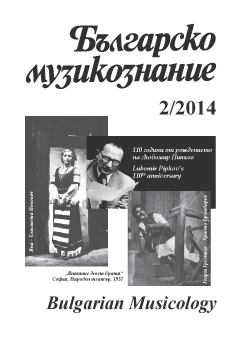Икона и чудовище
An icon and a monster
Author(s): Maria KostakevaSubject(s): Music
Published by: Институт за изследване на изкуствата, Българска академия на науките
Summary/Abstract: Avatar of Modеrnity. The Rite of Spring Reconsidered. The edition is dedicated to the 100th anniversary of the premiere of The Rite of Spring by Igor Stravinsky. Part of it features a facsimile of composers handwright full score – manuscript (annotated and edited by Ulrich Mosch) and the first ever publication of the composer’s piano version for four hands (edited by Felix Meyer) from the private collection of John Stravinsky, the composer’s grandson. Similar to a goldmine, this volume abounds in invaluable authentic material: sketches, scores, letters, previously unknown images that have been part of the archives of the Paul Sacher Foundation since 1983. The book is structured into five themed parts, each of them with extensive reference supplements. Coming from completely different cultural backgrounds, countries and areas of research yet sticking to the general concept of the publisher, the 19 authors introduce a number of new original ideas. All the essays in The Rite of Spring feature it as a once-in-a-century work, as a mirror of the age and vice versa, as the entire age focused in one work alone. Avatar of Modernity is not only an indispensable book about The Rite of Spring and the chronology of its emergence (Meyer, Garafola, Taruskin), about Stravinsky’s compositional style (Bleek, Meyer, Jeschke) and the great influence of this work on composing as such (Cross). It is also a book presenting modernism and the motley variety of its interpretations all along the twentieth century. Not least, it is also a book about the changing perspecharmonytives of reception of the work in various times and different geographical and cultural places. The book accentuates the national origins of the work. The dialectical relation between national and cosmopolitan, between archaism and modernity is viewed from a wide range of professional view points. The synthetic nature of The Rite of Spring, marked by Roerich’s visual aesthetics, Nijinsky’s holistic performance and Stravinsky’s paradoxical sound, is central to all the essays. The work is also viewed as a dark prophecy of the imminent war and the ensuing era of totalitarian regimes. The Rite of Spring, in Cross’s opinion, is a work that achieves the sublimity and significance of Beethoven’s Symphony No. 9.
Journal: Българско музикознание
- Issue Year: 2014
- Issue No: 2
- Page Range: 111-116
- Page Count: 6
- Language: Bulgarian
- Content File-PDF

